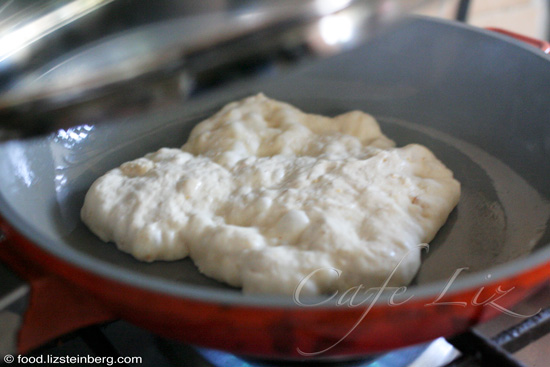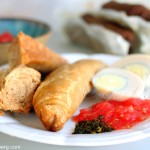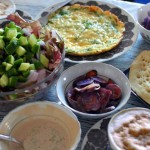
Walking through the Yemenite quarter one Friday morning, I passed an open window advertising fresh lahoh. What more of an invitation do I need?
But there was no one there. Peering inside, I couldn’t even see any bread — none of the telltale bags of stacked lahoh or saluf, full of condensation that keeps the flatbreads moist and fresh as they cool.
Across the street there was another sign in a window advertising lahoh. Eitan’s lahoh, it said. I’d passed it before, but I’d never stopped to check it out.
By then my mind was set on fresh bread, so I found my way inside, through a run-down courtyard into a dark little room. It was a veritable Yemenite pita factory. Piles of lahoh lined a table next to the door — they were finished making lahoh for the day. Flat griddles lined a wall, where the saluf were being made — handfuls of gooey dough were pulled from a mass in a plastic bucket, smeared into a circle on the griddle and then covered with metal hats until baked through. Men were crowded inside, buying bags of fresh bread — for a very reasonable 2.50 shekels per lahoh, and 3 shekels per saluf. In my excitement, I didn’t even think to ask to take a photo. Here they are at work:

The guys were nice enough to let me shoot a video, which hopefully shows the process — I didn’t realize my phone’s video option was quite this bad. This is the last of the saluf batter for the day.
Catch them if you can: They’re open until 8 every weekday — 8 A.M., that is — and until 1 or 2 P.M. on Fridays. In case those hours didn’t tip you off, they stock restaurants.
Lahoh and saluf are similar in spirit, round flatbreads made from a moist yeast dough that may include ground fenugreek seeds. Lahoh is basically made like an unflipped pancake, and I’ve had British people note that it resembles crumpets. Saluf is a relative of lafah, another kind of flat pita you’ll find here. Their prominence varies depending on the region of the country, and the number of Yemenite immigrants who settled there generations ago — while saluf rules the Carmel Market in Tel Aviv, it’s impossible to find in Jerusalem’s Mahane Yehuda market, where lafah reigns supreme.
Both kinds of Yemenite pitas can be eaten alongside salads, soups or stews, which is generally how they’re served at the restaurants in the Yemenite quarter. I’ll often fry lahoh filled with egg to make a Yemenite omelet, a quick meal that I learned from my friend Irit, who has a tiny restaurant in the neighborhood. Saluf I’ll eat as is — in theory it could be used with spreads, but it doesn’t usually last long enough.
You can make lahoh and saluf at home, although I often find it more convenient to buy them — I generally don’t want more than one or two at once, and they’re best fresh. But then again, not everyone has this as an option — maybe you don’t live close enough, or maybe you simply can’t make it to the Yemenite quarter before noon, at which point most places run out.
And there is one striking advantage to making your own saluf — that fresh, yeasty flavor that dissipates within minutes.
Saluf, alternately spelled salouf or saloof (or סלוף in Hebrew), was traditionally made in a taboun oven — the wet dough would be slapped against the taboun wall, and you knew the pita was ready when it fell off. Or so the story goes — I certainly don’t know anyone who makes it this way anymore. In the Yemenite quarter neighboring the Carmel market, you’ll find people who make saluf on a massive griddle under a grill pan, like at Eitan’s place — those metal domes contain an electric heating element. You can buy a simpler one that can be placed on top of a stovetop frying pan, so that the saluf browns on top as well (this thing, or to see it in use, look at the photos in this post, in Hebrew). I’ve seen them selling for about 80 shekels at the Carmel market. If you want taboun saluf, you’ll have to go to the Hatikva market on the other side of town.
For those making saluf at home — and not serious enough to own a grill pan — your options include a simple frying pan with a lid, or an oven. I’d imagine a pizza stone would be great for this. I used a frying pan, and while my pitas lack the brown spots that characterize professionally made saluf, they taste just as good.

I’ve also seen two techniques for making saluf, and I’m detailing them both here. The main variable is the quantity of water. You can add enough to get a sticky batter that you smear into the pan — at Eitan’s, they start with about two handfuls of gooey dough, and then smear it with a water-fenugreek seed mixture as they flatten it onto the griddle (as in the photo). The water keeps your hands (or rubber gloves) from sticking to the dough. They told me the griddle is oiled only once, when they start work; apparently that’s enough. On the other hand, they remove the bread from the grill with a huge metal spatula that would destroy my nonstick pans.
The other option is to use less water in order to get a dough stiff enough to knead and shape. This goes along with what my friend Irit told me, that saluf dough has the same consistency as jachnun dough. The few grandmothers whose recipes were recorded online seem to prefer this method, too.
I personally prefer using wetter dough, since for me it produced softer pitas, but both are reputable methods. There’s my saluf, bubbling up in the pan. I removed the lid only to take a photo.

This recipe is based on the guidance of my friend Irit, along with my observations from my favorite saluf.
For about 6 smallish saluf pitas:
- 2 cups flour
- 1 1/4 cups water (alternately, for dough you can roll out: 1 cup water)
- 1 teaspoon ground fenugreek seeds (hilbe in Hebrew)
- 1/2 teaspoon salt
- 1 teaspoon active dry yeast
Prep time: 10 minutes. Cook time: 30 minutes.
Mix together the ingredients to form a wet dough. It will be slightly too soft to knead. Mix with a fork or spoon instead. (ALTERNATELY: Use only 1 cup water, form a ball of dough, and knead for a few minutes),
Cover the bowl and set aside to rise, until the dough doubles in size. Stir again with the fork or spoon (this takes the place of kneading). Sit aside again. (TIP: In this cold weather, I heat my oven to the lowest setting for a few minutes, turn it off, and let the dough rise in there. Otherwise it’ll take all day.)
Heat a frying pan on a medium-high flame. Once the pan is relatively hot, turn down the flame to medium-low, and wipe with an oil-soaked paper towel. (If you put dough or batter into a cold pan, it’ll stick and you’ll have a messy disaster.)
IF YOU USED 1 1/4 CUPS WATER: Wet your hands so the dough won’t stick to them, and pull a big handful of dough off the mound in the bowl. Spread it into a round shape in the pan (if the pan is too oily, the dough won’t stick at all and this will be difficult). It doesn’t need to be excessively thin; some thickness gives a nice chewiness. Put a lid on the pan and let the saluf bake on low heat until dry on top — as long as 5 minutes. It should get thick and bubbly as it bakes.
IF YOU USED 1 CUP WATER: Punch down the risen dough and form into 6 balls. Flour and let rise again, briefly. Roll out each ball into a disc, though not too thin — you can just use your fingers to gently prod the dough into a fat circle. Put this disc into the oiled pan, cover, and let bake on a low flame until dry on top — as much as 5 minutes.
ALTERNATELY, USE AN OVEN INSTEAD OF A FRYING PAN: Heat your oven, and put the saluf — either the wet dough or the drier dough — onto a baking stone or tray in the oven. This will let the saluf brown lightly on top as well, giving it a more traditional appearance. You also could put pan-baked saluf into the oven to brown a bit on top.
Repeat your cooking method of choice with the remaining dough.
Let the saluf cool a bit. Store in a plastic bag so that they maintain their moisture and softness — every saluf you’ll buy comes out of a bag full of condensation, and if it doesn’t, there’s a good chance it’s stale.
Places to buy saluf/lahoh in the Yemenite quarter:
- Erez, Nahaliel 28 — this restaurant reliably has a nice stack of saluf and lahoh well into the late afternoon and even early evening hours, something that cannot be taken for granted. 3 shekels each.
- Eitan’s Lahoh, Nahaliel 18 — catch them while you can, if you happen to be in the Yemenite quarter before 8 A.M. on a weekday or 1 P.M. on a Friday. If you are, it’s worth it. 3 shekels for saluf, 2.50 for lahoh.
- There are a spattering of other Yemenite restaurants that also sell breads. I don’t recommend buying them from anyone in the main Carmel market strip. Consider yourself warned.
And, at the Hatikva market: Saluf Bakery, Hatikva 1, where they make saluf in a real oven.





